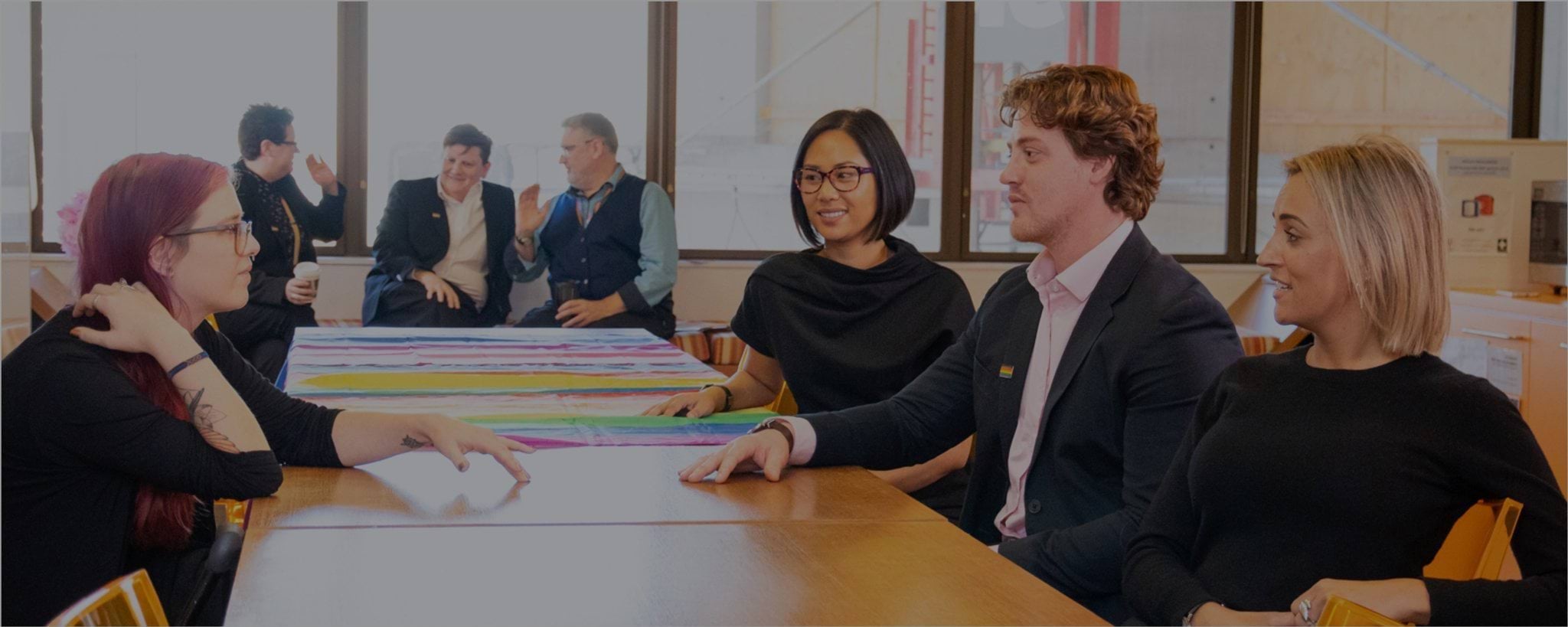Who is this guide for?
This guide is for public sector employees. Use it to ensure you use inclusive language for LGBTIQA+ people.
The guide aims to support public sector entities and their employees. We all have a responsibility to make Victoria a safer, fairer and more inclusive place for everyone.
Language is very powerful. It can be discriminatory, harmful and limiting. It can also provide people with the ability to describe their identities and experiences. We should always be mindful how we communicate with other people.
Language is always evolving
This inclusive language guide is not intended to be exhaustive or definitive. Definitions and meanings change over time as language evolves and as our understanding of who we are evolves. Meaning also varies across languages other than English and there are not always direct translations.
While this guide focuses on LGBTIQA+ inclusive language, it is important to remember that many different aspects can make up a person’s identity and experiences. This can include race, religion, gender identity, sexual orientation or sexuality, income or social status, age, ability or disability, or migration status as well as parenting or caring roles.
A list of resources is available at the end of this guide with more extensive information about other types of inclusive language.
What does the term ‘LGBTIQA+’ mean?
The Victorian Government uses the acronym LGBTIQA+ (lesbian, gay, bisexual, trans and gender diverse, intersex, queer, and asexual). This is an inclusive umbrella abbreviation of diverse sexualities, genders and sex characteristics.
Everyone has a sex, gender and sexuality, which relate to our bodies, identities and how we express ourselves.
Communities included within this commonly used umbrella term have distinct experiences and needs, and different histories of identity and organisation. In Australia, the term has arisen in recognition of common experiences of legal and social marginalisation on the basis of dominant social norms around sex, gender and sexuality.[1]
The plus sign indicates that there are many different terms used to describe identity, which are not all covered by the letters LGBTIQA.
Why are we adding the ‘A’?
The A is for asexual. This refers to a person who may experience partial or no sexual attraction but may or may not experience romantic attraction towards others. Asexual people can be of any gender or sexual orientation.
The Victorian Government is adopting the reference to asexual people, making its standard acronym LGBTIQA+. This addition responds to feedback from communities. It also ensures that the language we use remains inclusive and representative.
Some communities include other terms such as aromantic and agender can in the A. Our new acronym does not specifically call out these terms. We capture them within the +. The term ‘ace’ is sometimes used as an umbrella term for asexual and aromantic identities.
Why can’t I see the term I’m looking for?
Definitions and meanings of sexuality and gender continue to change over time. This guidance does not provide an exhaustive list of definitions. Each of the terms in this guide may be written or spoken about in different ways.
If you are unsure about specific terminology, ask the people and communities you are supporting. This ensures that language reflects their needs and identities. You can also consult the list of resources at the end of the guide for more information.
What is inclusive language?
Inclusive language is when we use words in ways that show our respect for people of all different backgrounds.
Inclusive language is free from words, phrases or tones that reflect prejudiced, stereotyped or discriminatory views of particular people or groups. It does not deliberately or inadvertently exclude people.
Inclusive language is about welcoming all people to take part in and contribute to our workplaces, schools, communities and services.
LGBTIQA+ inclusive language is a way of acknowledging and respecting the natural diversity of sex, gender and sexuality.
LGBTIQA+ inclusive language can come in three forms:
- verbal (for example, through spoken language)
- written (for example, through surveys or intake forms)
- visual (for example, through the display of LGBTIQA+ flags).
Why is inclusive language important?
How others describe us has an enormous impact on our health and wellbeing. A lack of inclusive communication contributes to discrimination that can prevent LGBTIQA+ people from accessing help.[2]
Using inclusive language can help to build trust between the Government and LGBTIQA+ communities. It also helps to address the discrimination that LGBTIQA+ people may face including any discrimination experienced by the children or families of LGBTIQA+ people.
When we use inclusive language, it encourages the wider Victorian community to use it too.
Our workplaces should also reflect the Victorian Public Sector Values and Code of Conduct. These include demonstrating respect and promoting human rights.[3] Pride in Our future: Victoria’s LGBTIQA+ strategy 2022-32 notes that government policies, programs and services should be safe, inclusive and accessible for all Victorians.[4]
Footnotes
[1] Rainbow Health Victoria, 2020, ‘Research Matters: What does LGBTIQ mean?’, available at: https://rainbowhealthaustralia.org.au/media/pages/research-resources/re…
[2] Brooks et al. 2018; Smith, Jones & Ward, 2014, cited in: Australian Institute of Family Studies, February 2022, https://aifs.gov.au/resources/practice-guides/inclusive-communication-lgbtiq-clients
[3] Victorian Public Sector Commission, https://vpsc.vic.gov.au/ethics-behaviours-culture/public-sector-values/
[4] Pride in Our future: Victoria’s LGBTIQA+ strategy 2022-32, https://www.vic.gov.au/pride-our-future-victorias-lgbtiq-strategy-2022-32.
Updated
